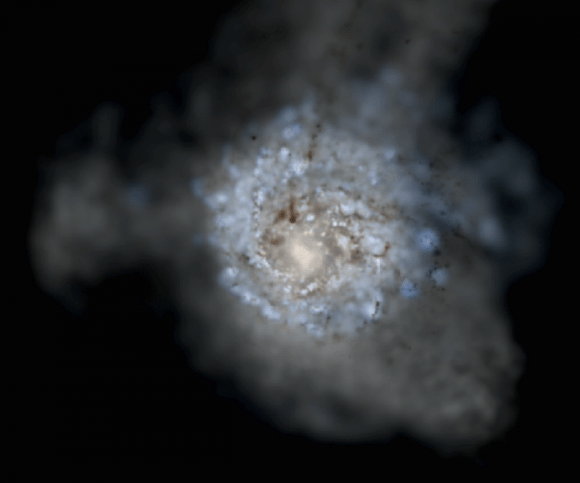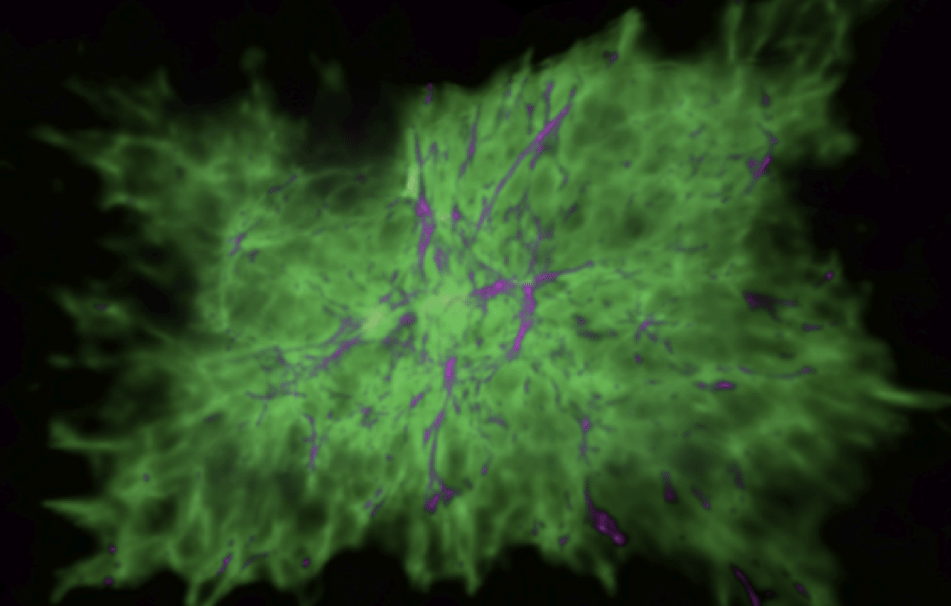For the first time, astronomers are able to accurately simulate galaxies from shortly after the big bang to today by including a realistic treatment of the effects stars have on their host galaxies.
For the past few decades astronomers have simulated galaxies by mixing the basic physical ingredients — gravity, gas chemistry and the evolution of the universe — into their models.
For years their simulations have shown that gas cools off quickly and falls to the center of the galaxy. Eventually all of the gas forms stars. But observations show only “10 percent of the gas in the universe actually does so,” CalTech astronomer Dr. Philip Hopkins explained. “And in very small or very large galaxies, the number can go down to well below a percent.”
Models of galaxies create far too many stars and as a result end up weighing more than real galaxies in the observable universe. But in theory the solution is simple: the missing physics is a process known as stellar feedback.
For that, astronomers have to look at how stars help shape the evolution of the galaxies in which they reside. And what they have found is that stars affect their environments drastically.
When stars are very young they are extremely hot and blast off a high amount of radiation into space. This radiation heats up and pushes on the nearby interstellar gas. Later on stellar winds – particles streaming from the surface of stars — also push on the gas, further disrupting nearby star formation. Finally, explosions as supernovae can push the gas to nearly sonic speeds.
While astronomers have understood the missing physics for quite a while, they have not been able to successfully incorporate it a priori into their models. Despite their efforts their simulated galaxies have always weighed more than observed galaxies actually weigh.
Understanding the missing physics is a completely different question than being able to incorporate the missing physics directly into their models.
Instead, astronomers made big assumptions based on what galaxies should look like. At some point in their simulations, they had to go in by hand and tune certain parameters. They would get rid of so much gas until the results roughly matched the galaxies we observe.
“Basically, they (astronomers) said ‘we need there to be winds to explain the observations, so we’re going to insert those winds by hand into our models, and adjust the parameters until it looks like what’s observed,’ ” Hopkins told Universe Today.
At the time tuning their models in this way was the best astronomers could do and their models did help improve our understanding of galaxy evolution. But Hopkins and a team of astronomers from across North America have found a way to incorporate the missing physics — stellar feedback — directly into their models.
The research team is creating simulations that draw from stellar feedback explicitly. The FIRE (Feedback in Realistic Environments) project is a multi-year, multi-institution effort.
While it was no easy task, they incorporated the necessary and dare I say messy physics into their models, allowing for unprecedented accuracy. They tracked the affects radiation and stellar winds have on their environments and included a realistic supernovae rate.
“The result is that we see these stars pushing on the gas, and supernovae explosions sweeping up and ‘blowing out’ large amounts of material from galaxies,” Hopkins explained. “When you follow all of this, the story holds together, and indeed we can explain the observed masses of galaxies just from the input of stars.”

The results have been rewarding — providing some pretty cool videos of galaxies forming across the observable universe — and surprising.
It has become clear that the different types of stellar feedback don’t work alone. While the energy given off by stellar winds can push away interstellar gas, it cannot launch the gas out of the galaxy entirely. The necessary propulsion occurs, instead, when a supernova explosion happens nearby.
But this isn’t to say that supernova explosions play a larger role than stellar winds. If the authors left out any stellar feedback mechanism (the radiation from hot young stars, stellar winds, or supernova explosions) the results were equally poor — with too many stars and masses much too large.
“We’ve just begun to explore these new surprises, but we hope that these new tools will enable us to study a whole host of open questions in the field.”
The paper has been submitted for publication in the Monthly Notices of the Royal Astronomical Society and is available for download here.
Hopkins discusses the “Cosmological zoom-in simulation using new stellar feedback” at at workshop at the University of California, Santa Cruz earlier this year:


See
into-at http://shahidurrahmansikder.wordpress.com
as I see it that the revolutionary concepts of the research results, shall be
kept in tact preserving your image all over the world, which is my ultimate
goal too.
Ok, everybody believe it now.